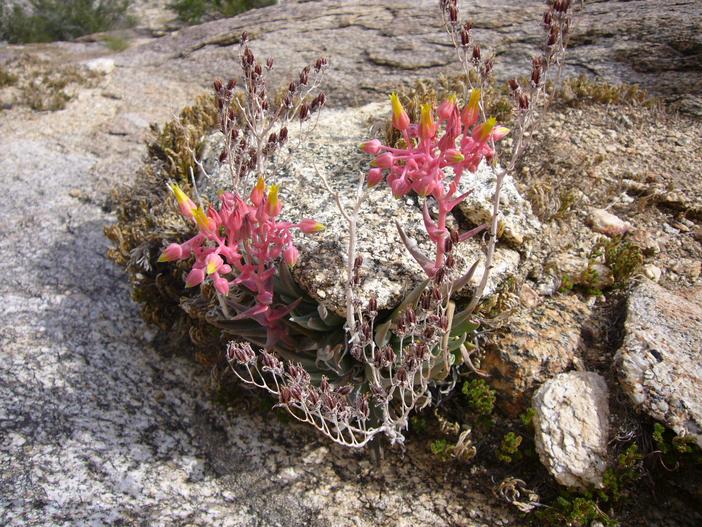Desert Dudleya
(Dudleya saxosa subsp. aloides)
Desert Dudleya (Dudleya saxosa subsp. aloides)
/
/

Florian Boyd
CC BY-SA 2.0
Image By:
Florian Boyd
Recorded By:
Copyright:
CC BY-SA 2.0
Copyright Notice:
Photo by: Florian Boyd | License Type: CC BY-SA 2.0 | License URL: https://creativecommons.org/licenses/by-sa/2.0 | Uploader: Flickr upload bot | Publisher: Wikipedia Commons


















Estimated Native Range
Summary
Dudleya saxosa subsp. aloides, commonly known as desert dudleya or desert savior, is a perennial succulent native to the rocky cliffs and slopes of the Peninsular Ranges and desert mountains in Southern California. It is adapted to a semi-arid climate with minimal rainfall, often found in shaded crevices or north-facing slopes that provide some respite from the intense sun. This species is evergreen or summer deciduous, depending on the harshness of its environment, and typically blooms from April to June, showcasing bright yellow or greenish-yellow flowers that attract pollinators such as bees and hummingbirds.
Desert dudleya is valued for its low water requirements and striking rosette form, making it a suitable choice for rock gardens, xeriscaping, and as a container plant. It thrives in well-drained soils, preferably gritty or sandy, and requires minimal maintenance once established. While it prefers partial shade, it can also tolerate full sun in cooler coastal areas. Gardeners should be cautious of overwatering, as this can lead to root rot. There are no significant disease issues, but mealybugs and aphids can sometimes be a problem. This plant is not known for aggressive roots or invasiveness.CC BY-SA 4.0
Desert dudleya is valued for its low water requirements and striking rosette form, making it a suitable choice for rock gardens, xeriscaping, and as a container plant. It thrives in well-drained soils, preferably gritty or sandy, and requires minimal maintenance once established. While it prefers partial shade, it can also tolerate full sun in cooler coastal areas. Gardeners should be cautious of overwatering, as this can lead to root rot. There are no significant disease issues, but mealybugs and aphids can sometimes be a problem. This plant is not known for aggressive roots or invasiveness.CC BY-SA 4.0
Plant Description
- Plant Type: Succulent
- Height: 0.5-1.5 feet
- Width: 0.5-1.5 feet
- Growth Rate: Slow
- Flower Color: Green, Yellow
- Flowering Season: Spring, Summer
- Leaf Retention: Evergreen
Growth Requirements
- Sun: Full Sun, Part Shade
- Water: Low
- Drainage: Medium, Fast
Common Uses
Bee Garden, Drought Tolerant, Fire Resistant, Low Maintenance, Rock Garden, Showy Flowers
Natural Habitat
Native to the rocky cliffs and slopes of the Peninsular Ranges and desert mountains in Southern California, adapted to a semi-arid climate
Other Names
Common Names:
Scientific Names: , Dudleya saxosa subsp. aloides, Cotyledon aloides, Cotyledon delicata, Cotyledon grandiflora, Dudleya alainae, Dudleya alainiae, Dudleya aloides, Dudleya delicata, Dudleya grandiflora
GBIF Accepted Name: